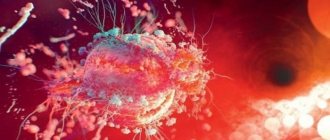GGT (gamma-glutamyl transferase or gamma-glutamyl transpeptidase) is an enzyme involved in the metabolism of amino acids.
It is found in the highest concentrations in the kidneys, liver, and pancreas, and is present in smaller quantities in other tissues of the body. The highest levels of GGT are found in renal tissue; the enzyme present in serum comes mainly from the hepatobiliary system. An increased concentration of GGT in the blood serum is most often a marker of impaired bile outflow (cholestasis), as well as intoxication caused by alcohol or drugs.
In what cases is research usually prescribed?
A blood test for GGT is important for diagnosing liver pathology; for this purpose it is usually prescribed along with the following tests: AST, ALT, bilirubin, alkaline phosphatase. GGT is highly informative in identifying obstructive jaundice, cholangitis and cholecystitis; the increase in the level of this indicator begins earlier than that of other liver markers and lasts longer.
In viral hepatitis, GGT does not increase much, and in this case, determination of transaminases (ALT, AST) is more useful. High levels of GGT are observed in cases of impaired bile outflow, obstructive processes in the liver (tens of times higher than normal), in the presence of primary or secondary (metastases) neoplasms, and in cirrhosis.
Treatment of elevated GGT in the blood: how to lower and return to normal
Treatment of elevated GGT levels begins with diagnosing the condition of the body and identifying the exact cause of the increase in this enzyme. Treatment of diseases that cause increased gamma-glutamyl transferase can reduce its level.
In addition to drug treatment, it is necessary to adjust your diet. A menu rich in fruits and vegetables helps reduce GGT. First of all, these are plant foods rich in vitamin C, fiber, beta-carotene and folic acid:
- carrot;
- leaf salad;
- spinach;
- apricots;
- pumpkin.
It is necessary to stop smoking and drinking alcohol. Recommendations from the World Health Organization on how to quit smoking and how to stop drinking will help you get rid of these habits.
- increased ALT and AST - increased bilirubin - platelets above and below normal - increased and decreased albumin
Treatment of elevated GGT levels begins with diagnosing the condition of the body and identifying the exact cause of the increase in this enzyme. Treatment of diseases that cause increased gamma-glutamyl transferase can reduce its level.
It is necessary to stop smoking and drinking alcohol. Recommendations from the World Health Organization on how to quit smoking and how to stop drinking will help you get rid of these habits.
To diagnose diseases of the liver or pancreas, you can donate blood from a vein for GGT. This abbreviation stands for gamma-glutamyl transpeptidase. If you receive results in which the gamma of HT is increased, then this may indicate gallstones, toxic liver damage, alcoholism, diabetes mellitus, pancreatitis in the acute or chronic phase, hyperthyroidism, even prostate, liver or pancreatic cancer.
What do the test results mean?
The normal concentrations of gamma-glutamyltransferase in the blood vary depending on gender and age.
An increase in gamma-glutamyl transpeptidase (GGT) activity is observed in various liver pathologies. The highest levels indicate biliary obstruction, which may be hepatic or extrahepatic in nature, alcoholic liver disease and cirrhosis. In combination with an increase in alkaline phosphatase, it is typical for hepatobiliary diseases. Elevated values are also observed in patients taking drugs such as phenytoin and phenobarbital.
Simultaneous elevation of GGT and alkaline phosphatase suggests cholestasis. With long-term alcohol consumption, GGT increases independently of alkaline phosphatase. An increase in alkaline phosphatase with normal GGT values indicates the presence of bone tissue diseases. In muscle diseases, renal failure and pregnancy with increased alkaline phosphatase, normal GGT values are observed.
Gamma-glutamyl transpeptidase (GGT)
Gamma-glutamyl transpeptidase is an enzyme (protein) of the liver and pancreas, the activity of which in the blood increases with liver disease and alcohol abuse.
Research method
Kinetic colorimetric method.
Units
U/L (unit per liter).
What biomaterial can be used for research?
Venous, capillary blood.
How to properly prepare for research?
- Do not eat for 12 hours before the test.
- Avoid physical and emotional stress and do not smoke for 30 minutes before donating blood.
General information about the study
Gamma-glutamyl transpeptidase is an enzyme that is found in the cells of the liver and biliary tract and is a catalyst for certain biochemical reactions. It is not contained in the bloodstream, only in cells, when destroyed, their contents enter the blood. Normally, some cells are renewed, so a certain GGT activity is detected in the blood. If many cells die, its activity can increase significantly.
What is the research used for?
To confirm liver and bile duct disease.
- To monitor the effectiveness of treatment for alcoholism or alcoholic hepatitis.
- For the diagnosis of diseases affecting the biliary tract.
- To determine whether the increase in alkaline phosphatase activity is due to liver disease or bone pathology.
What do the results mean?
| Age, gender | Reference values |
| 12 - 17 years old, male | |
| 12 – 17 years old, female | |
| > 17 years old, male | 10 – 71 U/l |
| > 17 years old, female | 6 – 42 U/l |
Most often, the following statement is true: the higher the GGT activity, the more severe the damage to the liver or bile ducts.
Reasons for increased GGT activity
Damage to the liver and biliary tract
- Mechanical jaundice associated with obstruction of the bile ducts. — Bile duct stones, bile duct scars after surgery. — Tumors of the bile ducts. — Cancer of the head of the pancreas, stomach cancer due to mechanical compression of the common bile duct.
- Alcoholism. After quitting alcohol, GGT activity returns to normal within a month.
- Liver cancer, metastases of tumors of other organs to the liver.
- Cirrhosis of the liver.
- Acute and chronic hepatitis of any origin, especially alcoholic.
- Infectious mononucleosis.
- Primary biliary cirrhosis and primary sclerosing cholangitis.
Other reasons
- Pancreatitis is acute inflammation of the pancreas.
- Prostate cancer.
- Breast and lung cancer with liver metastases.
- Systemic lupus erythematosus.
- Myocardial infarction. GGT may rise after 3 to 4 days, reflecting liver involvement secondary to heart failure.
- Heart failure.
- Hyperthyroidism – increased function of the thyroid gland.
- Diabetes.
Reasons for decreased GGT activity
- Hypothyroidism is a condition in which the function of the thyroid gland is reduced.
Preparing for analysis
To avoid false indicators in the final results table, it is recommended to follow preparation measures. By following the rules listed below, the results will be the most reliable, which will help to correctly diagnose or refute the disease.
- Blood is donated on an empty stomach. To avoid deviations in blood counts caused by activation of enzymes due to food intake.
- Refuse to eat fatty, highly salted, spicy, overcooked foods that are difficult for the body for at least twenty-four hours (preferably forty-eight hours).
- It is recommended to give up physical activity two days in advance, since physical effects on the body also affect the final results;
- A visit to a sauna, steam bath, or hot bath the day before can lead to fluctuations in normal values. You should avoid visiting places where the body is exposed to thermal effects;
- Limit alcohol intake and cigarette consumption at least 24 hours before the upcoming test;
- Stop using medications at least two days before the test. Drugs of certain groups can affect the parameters of a biochemical blood test.
Come to donate blood 10-15 minutes in advance. This is necessary so that the body calms down, shortness of breath goes away, and the body acclimatizes to the temperature conditions of the room (especially after a cold street). If you are very hungry, it is better to take food with you and satisfy your hunger immediately after blood collection.
Treatment and adjustment of indicators
If, according to the test results, gamma-GT is increased, how to correct this indicator must be determined with a doctor. After all, it is not the enzyme level that needs to be treated, but the reason that caused its increase. So, if it is increased due to excessive alcohol consumption, then there is only one way out - to give up alcohol.
In other cases, it is impossible to do without consulting a specialist. If we are talking, for example, about pancreatitis, then a diet is important, in which you should give up fried and fatty foods, chocolate, and coffee. It is also a good idea to take medications that affect liver function. Some patients with hepatitis are prescribed a drug such as Ursofalk. It can also be used for jaundice in newborns to help establish normal liver function.
GGT in a biochemical blood test in combination with other tests is often used to diagnose the condition of the liver, since its highest concentration is found in this organ. But although GGT is elevated in the blood during many diseases in which damage to the liver and bile ducts occurs, other pathologies, for example, those associated with the heart, can provoke its increase.
Tumor processes
Cancer of the liver and other organs of the hepatobiliary system can be primary or metastatic. If cancer cells multiply in organs, liver function tests and gamma-GT begin to be released in increased volume. For large tumors, the analysis transcript shows a serious excess of the indicator - 10 times or more.
In the initial stages of oncology, the excess of the enzyme can be moderate.
Among other things, a pancreatic tumor can cause changes in tests. This organ is responsible for the production of a number of amino acids, which include gamma-glutamyl transpeptidase.
Therefore, after treatment, the amount of enzyme in the blood stabilizes, and in case of relapse it usually increases. A moderate increase in the number can indicate the presence of cysts and other benign tumors.
Reasons and mechanism for increasing enzyme activity
Gamma-glutamyl transpeptidase is directly involved in amino acid metabolism. It is a catalyst for the transfer of the gamma-glutamyl residue from the gamma-glutamyl peptide. The main organ where this enzyme is located is the kidneys: their content there is 7000 times higher than the amount in blood serum.
Gamma-GT analysis is elevated usually due to increased activity of this enzyme. And it manifests itself when problems with the liver or biliary tract begin. Normally, GGT activity is insignificant; it is directly related to the excretion of the enzyme, which is synthesized in the liver. That is why, even when minor problems appear, gamma GT increases.
Diagnosis of diseases
1. Cholestasis - the amount of the enzyme increases in both extrahepatic and intrahepatic forms of the disease. In this case, problems such as gallstones, obstructive jaundice caused by a liver tumor, and cholangitis appear.
2. Acute hepatitis of viral etiology, various toxic diseases.
3. Chronic hepatitis.
4. Pancreatitis - GGT will be increased both in acute and chronic forms.
6. Oncological diseases of the liver, pancreas or prostate.
In addition, if you are taking oral contraceptives, barbiturates, estrogens, or cephalosporins, your gamma TG levels may also be increased. You should not try to diagnose your illnesses yourself; only a doctor can diagnose them.
Increased Gamma GT in women
Standard GGT levels in women may be slightly increased in the following cases:
- oncological formations in the mammary gland;
- use of hormonal contraceptives or drugs to maintain the balance of female hormones;
- during pregnancy.
First of all, the root cause is eliminated, followed by strict adherence to the diet and drug support for the liver. In the most extreme cases, surgical intervention is indicated (for oncology).









